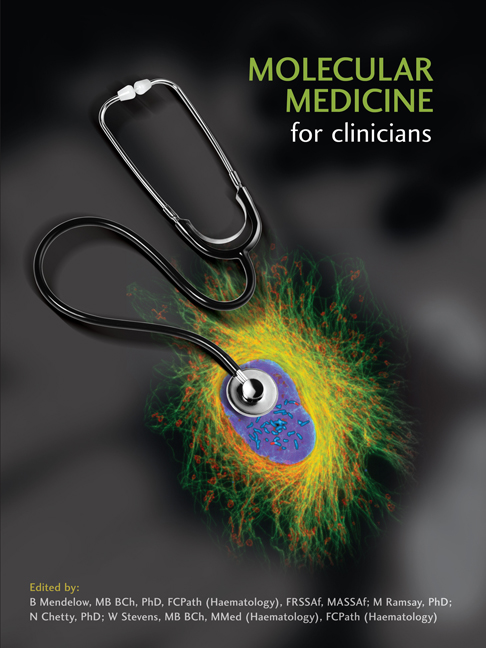Book contents
- Frontmatter
- Contents
- Foreword
- Acknowledgements
- Chapter 1 Introduction
- Keynote Essay 1: Defining Who We Are: DNA in Forensics, Genealogy and Human Origins
- Section 1 Principles Of Cellular And Molecular Biology
- SECTION 2 MOLECULAR PATHOLOGY
- Chapter 8 Genomes and the Environment: An Overview of Molecular Pathology
- Chapter 9 Genetics, Genomics, Health and Disease: General Considerations
- Chapter 10 Chromosome Disorders
- Chapter 11 Mendelian Inheritance
- Chapter 12 Unusual Molecular Processes that Impact on Disease
- Chapter 13 Population Genetics
- Chapter 14 Complex Multifactorial Inheritance
- Chapter 15 Molecular Basis for Phenotypic Variation
- Chapter 16 Medical Genetics
- Keynote Essay 3: Human Cloning: Should We Go There?
- Chapter 17 Neoplasia: General Considerations
- Chapter 18 Oncogenes
- Chapter 19 Mammalian DNA Repair
- Chapter 20 Tumour Suppressor Genes and Inherited Susceptibility to Cancer
- Chapter 21 Carcinoma
- Chapter 22 Leukaemias and Lymphomas
- Chapter 23 Molecular Approaches to the Diagnosis, Prognostication and Monitoring of Cancer
- Keynote Essay 4: Microbes, Molecules, Maladies and Man
- Chapter 24 Molecular Basis of Infectious Diseases: General Considerations
- Chapter 25 Immunology
- Chapter 26 Human Immunodeficiency Virus
- Chapter 27 Tuberculosis
- Chapter 28 Malaria
- Chapter 29 Influenza
- Chapter 30 Oncogenic Viruses
- Chapter 31 Vaccines and Immunisation
- Keynote Essay 5: Drugs and the 21st Century
- SECTION 3 MOLECULAR THERAPEUTICS
- SECTION 4 RESEARCH AND THE CONTINUING EVOLUTION OF MOLECULAR MEDICINE
- Glossary
- Contributors’ Biographies
- Source Material And Recommended Reading
- Permissions And Credits
- Index
Chapter 26 - Human Immunodeficiency Virus
from SECTION 2 - MOLECULAR PATHOLOGY
Published online by Cambridge University Press: 04 June 2019
- Frontmatter
- Contents
- Foreword
- Acknowledgements
- Chapter 1 Introduction
- Keynote Essay 1: Defining Who We Are: DNA in Forensics, Genealogy and Human Origins
- Section 1 Principles Of Cellular And Molecular Biology
- SECTION 2 MOLECULAR PATHOLOGY
- Chapter 8 Genomes and the Environment: An Overview of Molecular Pathology
- Chapter 9 Genetics, Genomics, Health and Disease: General Considerations
- Chapter 10 Chromosome Disorders
- Chapter 11 Mendelian Inheritance
- Chapter 12 Unusual Molecular Processes that Impact on Disease
- Chapter 13 Population Genetics
- Chapter 14 Complex Multifactorial Inheritance
- Chapter 15 Molecular Basis for Phenotypic Variation
- Chapter 16 Medical Genetics
- Keynote Essay 3: Human Cloning: Should We Go There?
- Chapter 17 Neoplasia: General Considerations
- Chapter 18 Oncogenes
- Chapter 19 Mammalian DNA Repair
- Chapter 20 Tumour Suppressor Genes and Inherited Susceptibility to Cancer
- Chapter 21 Carcinoma
- Chapter 22 Leukaemias and Lymphomas
- Chapter 23 Molecular Approaches to the Diagnosis, Prognostication and Monitoring of Cancer
- Keynote Essay 4: Microbes, Molecules, Maladies and Man
- Chapter 24 Molecular Basis of Infectious Diseases: General Considerations
- Chapter 25 Immunology
- Chapter 26 Human Immunodeficiency Virus
- Chapter 27 Tuberculosis
- Chapter 28 Malaria
- Chapter 29 Influenza
- Chapter 30 Oncogenic Viruses
- Chapter 31 Vaccines and Immunisation
- Keynote Essay 5: Drugs and the 21st Century
- SECTION 3 MOLECULAR THERAPEUTICS
- SECTION 4 RESEARCH AND THE CONTINUING EVOLUTION OF MOLECULAR MEDICINE
- Glossary
- Contributors’ Biographies
- Source Material And Recommended Reading
- Permissions And Credits
- Index
Summary
INTRODUCTION
The emergence of the acquired immuno deficiency syndrome (AIDS) and human immuno deficiency virus (HIV) infection has undoubtedly been one of the most important events in medicine in the last 25 years. The first descriptions of AIDS arose in the United States of America in 1981, recognised as clusters of unusual disease presentations in young homosexual men. Within a few years, similar clinical pictures of acquired immuno deficiency were observed in injection drug users, a few infants, and blood transfusion recipients. By the middle and late 1980s it had become apparent that HIV infection was spreading rapidly among the heterosexual population throughout the world. By the late 1990s, the highest rates were being reported in developing countries in sub-Saharan Africa.
HIV is currently responsible for significant morbidity and mortality worldwide. The World Health Organization (WHO) and UNAIDS estimated that by the end of 2007 over 33.2 million people were living with HIV/AIDS worldwide, and over 30 million people (adults and children) have died due to this disease. It is also estimated that during 2007 2.5 million people became newly infected. Global statistics on HIV infection are published annually (http://www.unaids.org), and these data clearly show that the major burden of HIV/AIDS is currently borne in sub-Saharan Africa. South Africa accounts for at least 8% of global infections, an estimated 5.5 million adults and children living with HIV. Approximately 18.8% of the adult population between ages 15 and 49 are affected, with a disproportionate burden of infection being borne by women. High rates of mother-to-child trans mission continue to fuel the paediatric epidemic, and it is estimated that approximately 300 000 children are infected and may require initiation of anti -retro viral therapy. Annual national antenatal surveillance showed a 29.1% prevalence of HIV in the pregnant adult population in 2007, and the figures in this group have risen steadily for over a decade. A systematically sampled national house hold HIV prevalence survey conducted in 2005 estimated the HIV pre - valence in the general South African population as 10.8%.
AIDS is unique in its devastating impact on national development. The social and economic consequences of the disease are felt widely in all sectors including health, education, industry, agriculture, transport and human resources.
- Type
- Chapter
- Information
- Molecular Medicine for Clinicians , pp. 311 - 324Publisher: Wits University PressPrint publication year: 2008



